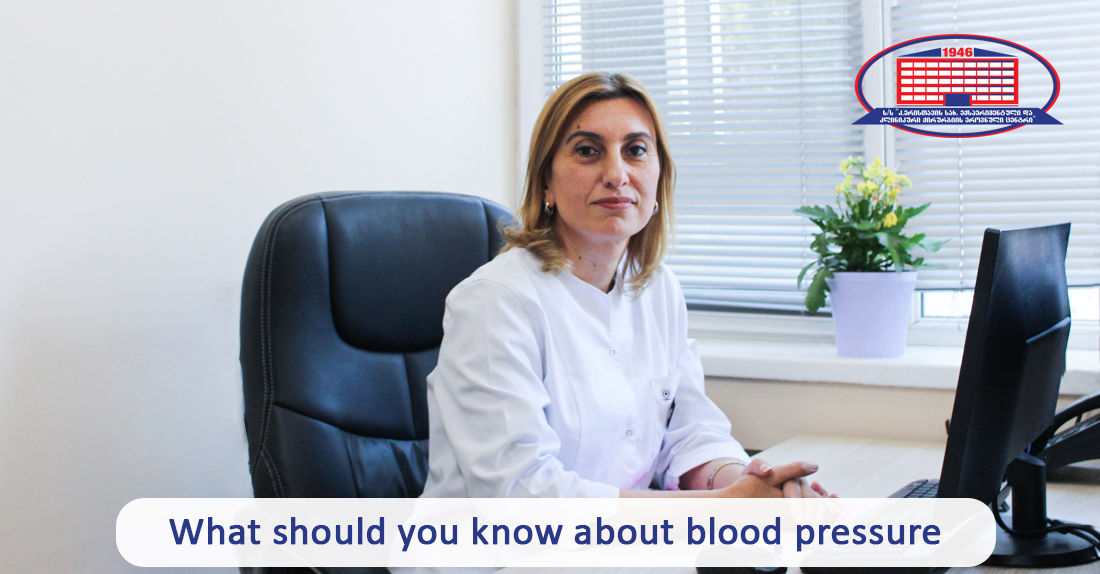
Blood pressure is a pressure in the blood that develops as a result of a heartbeat.
In the interview, you will be informed about the following:
Blood pressure level is different in arteries, veins, and capillaries and presents one of the indicators of the body's functional state.
Generally, the probability of hypertension development increases after the age of 55, albeit lately it has been noticed in much younger ages.
Blood pressure control and special attention are required for people with cardiovascular diseases in genes. Given the inheritance, blood pressure control is recommended from an early age. Moreover, patients affected by diabetes and overweight people should control blood pressure to prevent numerous complications.
It should be mentioned that high blood pressure, i.e., hypertension negatively affects various organs and systems.
Hypertension is one of the primary risk-factors for developing myocardial infarction, stroke, heart, and renal failure.
In already diagnosed hypertension, regular blood pressure control, two times a day, in the morning and evening before sleep, is necessary.
Cardiologist of National Center of Surgery Khatuna Berinashvili discusses the topic.
– What primary symptoms characterize high blood pressure?
– Hypertension at early stages and in the long term can progress without complaints. At first, the patient doesn’t suffer from any specific symptoms and commonly, s/he will notice it during random measurement of blood pressure. In rare cases, but it still might have the following presentations: headache, dizziness, fatigue, dyspnoea, shortness of breath, heart palpitation during physical stress. Also, it’s quite possible to feel chest pain, pulsation in the back of the head. Characterizes with nosebleeds and red skin.
– What can you tell us about low blood pressure and its’ signs?
–Hypotension (low blood pressure) is a clinical syndrome (a combination of symptoms) that characterizes with a decrease of blood pressure in men – 100/60 millimeters of mercury, whereas in women, lower than 95/60 millimeters of mercury. It develops as a result of various factors and presents a clinical syndrome comprising distinctive symptoms.
Following is the clinical presentation of hypotension:
- General weakness;
- Dizziness ;
- Blurred vision;
- Noise in the ears;
- The headache of different sites, intensity, and duration;
- Tachycardia (heart rate acceleration);
- Numbness and coldness in extremities;
- Loss of consciousness
Cause of hypotension might be the following:
- Cardiovascular system diseases (myocardial infarction, arrhythmia, heart failure, etc);
- Hypovolemia (decrease in the amount of blood circulating in the body);
- Endocrine diseases (adrenal cortex insufficiency, hypothyroidism);
- Post-infectious diseases and intoxication (poisoning) state.
Low blood pressure can be acute that develops in myocardial infarction, arrhythmia, traumatic shock, bleeding, acute peritonitis, and chronic in the following categories:
- Physiological hypotension (athletes, people in manual labor whose body adjusts to economical consumption of oxygen in manual labor)
- Primary (the result of stress, mental or physical tension);
- Secondary that presents a sign of various diseases (head and brain injury, osteochondrosis, cirrhosis, anemia).
– What is good blood pressure, i.e., what should blood pressure reading indicate?
– Hypertension is defined as systolic blood pressure = 140 mm Hg and/or diastolic blood pressure = 90 mm Hg. Mentioned is based on data from a varied randomized controlled trial.
According to hypertension management JNC 7 guidelines, there are 3 categories of blood pressure and they are:
- Normal (systolic
- Prehypertension (systolic 120-139 mm Hg and/or diastolic 80-89 mm Hg);
- Hypertension: A) stage I (systolic 140–159 mm Hg and/or diastolic 90–99 mm Hg); B) stage II (systolic >160 mm Hg and/or diastolic >100 mm Hg).
– If a person has no discomfort and doesn't have any complaints, should s/he still measure the blood pressure?
– Hypertension is an increase in blood pressure (≥140/90 mmHg) measured several times. Therefore, single blood pressure reading after physical and emotional stress doesn’t mean that the person has hypertension. We’ve already overviewed the symptoms of hypertension and if you don’t have those complaints, it’s not necessary to frequently measure blood pressure.
Wish you health!
What are patients interested in
coronarography
Qauestion:: My husband had a heart attack in May 2019 as per documents hereto attached and we are now looking for further treatment (either putting another stent or coronary artery bypass surgery (shunting), can you please advise the best focal point to contact to discuss method of treatment – either surgery or putting stent? I am sorry, the case history is in Russian and can be translated upon request. Thank you for your time!
Bradycardia
Qauestion:: I took a heart ultrasound that showed no pathologies. Albeit, I still have issues with my heart. I often feel my heart rate weakening, measured once it can be – 80 and if measured in 10 minutes, it can be 65-70. Can it be a heart pathology or neurosis? And besides ultrasound, is there any examination that detects hidden pathologies of the heart at your clinic and how much does it cost?
Arrhythmia
Qauestion:: Hello, I’m 16 years old and it’s been a month since the onset of following symptoms: a rapid heartbeat, I feel it in my hands, legs, back, as well as in my gastric cardia and I also feel the pulsation in the abdomen after I eat. What can be the cause of these?







